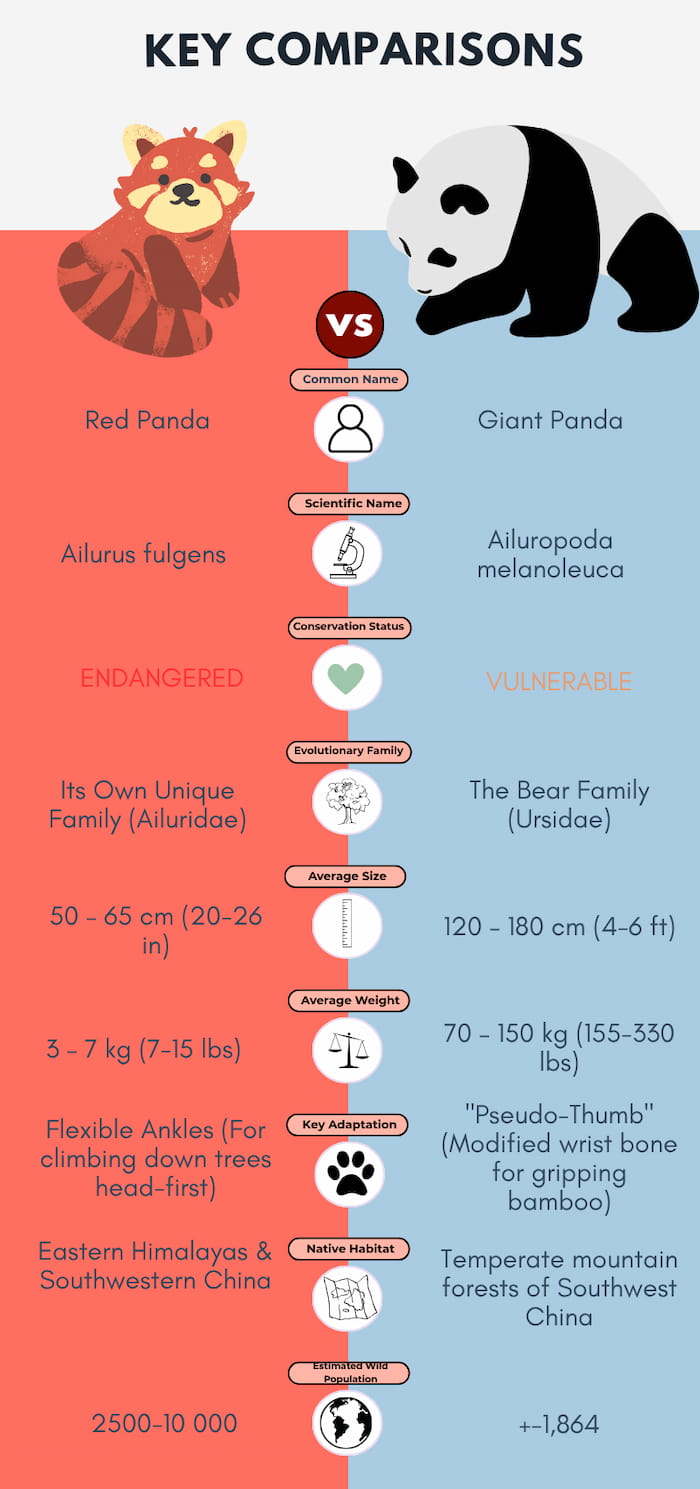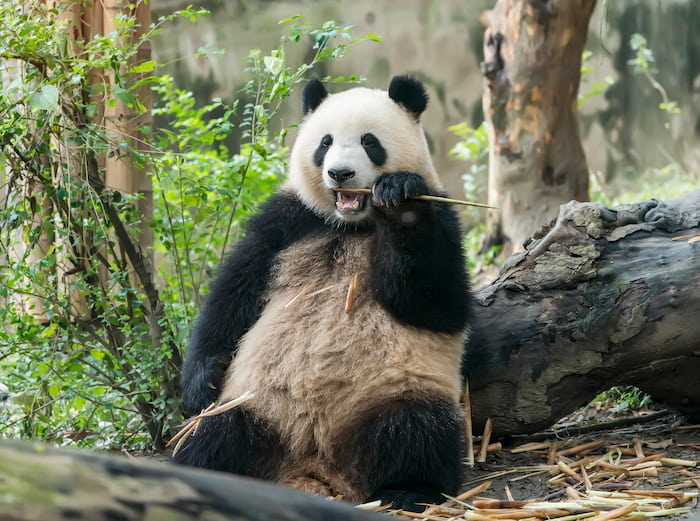The Panda Paradox: Divergent Lives of Giant and Red Pandas

When you think of "Pandas", what exactly comes to mind? Usually, the word "panda" brings up a singular image: the iconic Giant Panda, a cute and beloved black-and-white bear peacefully munching on bamboo in the misty mountains of China. However, the world of pandas extends far beyond what is typically known. Alongside the famous behemoth that is the Giant panda, there exists a smaller, fiery-furred creature — the Red Panda — that also bears the wondrous panda name.
They share a name and a love for bamboo, and their foreseeable futures are intertwined by their mountainous Asian homes. Despite these commonalities, their evolutionary stories, biological traits, and conservation journeys are remarkably distinct. This article succinctly delves into these two captivating mammals, revealing their unique adaptations, the challenges they face, and highlighting the corresponding urgent need for our help to preserve them.
The name "panda" itself is thought to originate from the Nepali phrase "nigalya ponya," meaning "bamboo eater" — a dietary link that is the primary reason for their shared nomenclature. The Red Panda (Ailurus fulgens) was first scientifically described in 1825. Nearly half a century later, in 1869, the Giant Panda (Ailuropoda melanoleuca) was introduced to Western science and was also named "panda" due to its bamboo-centric diet.
Despite these commonalities, key differences set them apart:
- Giant Panda (Ailuropoda melanoleuca): A true member of the Ursidae family. It is listed as Vulnerable by the IUCN (The International Union for Conservation of Nature), with an estimated wild population of around 1,864 individuals. Its diet is overwhelmingly specialised, with bamboo comprising 99% of its food intake.
- Red Panda (Ailurus fulgens): The sole living member of its own distinct family, Ailuridae. It is classified as Endangered by the IUCN, with an estimated wild population of around 2500 to 10000 mature individuals. While it also primarily eats bamboo, its diet is slightly more varied, sometimes including fruits and insects.
A Tale of Two Pandas: An Intertwined Evolutionary Journey
The assumption of a close relationship due to the shared name is a common misconception and an understandable one. As genetic studies confirm, the Giant Panda is a true bear, while the Red Panda's closest living relatives are musteloids, a group that includes weasels, raccoons, and skunks. Their evolutionary lineages are thought to have diverged approximately 43 million years ago.
Their most striking similarities — particularly their reliance on bamboo and the presence of a "false thumb" (a modified wrist bone used for gripping stalks) — are remarkable examples of "convergent evolution". This type of evolution is a phenomenon that occurs when unrelated species independently evolve similar traits as they adapt to similar environments or ecological niches.
Fascinatingly, comparative genomic studies have even identified specific genes involved in limb development and nutrient digestion that show signs of this convergence. The umami taste receptor gene, TAS1R1, appears to have lost its function in both pandas, a change likely linked to their specialised, low-protein herbivorous diet. This journey to accurately classify these animals mirrors the progress of science itself, moving from classifications based on physical appearance to the precision of DNA analysis, which solidified the Giant Panda within the bear family and the Red Panda in its own unique family, Ailuridae.

The Giant Panda: An Enduring Symbol of Conservation
The Giant Panda (Ailuropoda melanoleuca) is a global conservation icon, recognised by its striking black-and-white coat, which is thought to provide camouflage in both snowy and shady habitats. These large bears (120–180 cm long, 70–150 kg) are surprisingly skilled climbers, able to scale trees to rest or escape threats. A rare subspecies, the Qinling panda (Ailuropoda melanoleuca qinlingensis), found only in the Qinling Mountains, displays a distinctive dark and light brown coat and diverged from the more common black-and-white population around 300,000 years ago.
Native to the temperate mountain forests of Southwest China, their habitat is defined by a dense bamboo understory. Despite belonging to the Order Carnivora, their diet is famously specialised: 99% is bamboo. Their inefficient digestive system necessitates consuming enormous quantities — between 12 and 38 kg of bamboo every day, which can take up to 14 hours. This specialisation makes them incredibly vulnerable to any threats affecting bamboo availability. Giant Pandas are typically solitary, communicating via scent marking and vocalisations. Their reproductive rate is slow; females usually raise a single, tiny cub that becomes independent at around 18 months, and they live for 15–20 years in the wild.

The Red Panda: The Original "Firefox"
The Red Panda (Ailurus fulgens), often nicknamed the "firefox," is significantly smaller than its namesake, roughly the size of a large domestic cat (50–65 cm body, 3–7 kg weight). Its vibrant, reddish-brown fur provides excellent camouflage among the moss- and lichen-covered trees of its forest home, while its long, bushy, ringed tail aids with balance and provides warmth in the cold.
This mesmerising mammal showcases numerous adaptations for an arboreal (tree-based) lifestyle, including sharp, semi-retractable claws and highly flexible ankles that allow it to descend trees headfirst. The Red Panda inhabits temperate forests of the Eastern Himalayas and Southwestern China, typically at altitudes between 2,200 and 4,800 metres. Critically, almost 50% of their global habitat lies within the Eastern Himalayas, a fact that makes international cooperation essential for the species' survival due to the transboundary nature of its living parameters.
Like the Giant Panda, the Red Panda primarily eats bamboo but supplements its diet with fruits, acorns, insects, and the occasional small vertebrate. These animals are mainly arboreal, solitary, and most active at dusk, dawn, and during the night.
A Question of Identity: One Red Panda Species or Two?
The taxonomy of the Red Panda has recently become a topic of intense scientific discussion. Traditionally, two subspecies were recognised: the Himalayan Red Panda (A. f. fulgens) and the Chinese Red Panda (A. f. styani). Between these two subspecies, the Chinese subspecies (A. f. styani) is differentiated by being generally larger with a deeper red coat, once again owed to a diverging evolutionary history.
However, groundbreaking genetic research published in 2020 suggests these two lineages could be distinct species that diverged around 250,000 years ago, separated by major rivers. If this two-species classification (Ailurus fulgens for the Himalayan and Ailurus styani for the Chinese) is widely adopted, it could significantly impact conservation strategies, particularly as the Himalayan Red Panda reportedly has lower genetic diversity and a smaller population. However, the proposal is not universally accepted. Some scientists caution that splitting the species could complicate existing, cross-border conservation efforts for an already undersupported animal, while others argue that this specificity is exactly what is needed to create more targeted and effective conservation plans for each unique population.

Conservation Crossroads: Shared Threats, Different Destinies
The Giant Panda is listed as Vulnerable by the IUCN, an encouraging improvement from its previous "Endangered" status, thanks to decades of effective conservation programmes in China. The wild population has grown to an estimated 1,864 individuals, with another 670 in conservation centres. However, threats from habitat fragmentation and the future impacts of climate change remain serious concerns for the future of these bears.
The Red Panda, however, is still listed as Endangered. This reflects a devastating suspected population decline of 50% over the last two decades. The global wild population is estimated at fewer than 10,000 mature individuals, and may be as low as 2,500. Accurate surveying across its remote, rugged habitat is incredibly difficult, hence the wide variability in population estimates.
What exactly are the threats to both Pandas?:
- Habitat Loss and Fragmentation: This remains the primary threat, as forests are cleared for agriculture, logging, and infrastructure. This process isolates panda populations into small islands, preventing breeding and reducing their genetic diversity. For the Red Panda, the loss of mature, hollow trees is especially critical as they are essential for nesting.
- Climate Change: Bamboo, their shared lifeblood, is highly sensitive to climate shifts. Research predicts that large swathes of bamboo habitat could be lost in the coming decades, altering its distribution faster than pandas can adapt or migrate. The Red Panda also has a narrow temperature tolerance, making warming conditions a direct threat.
- Poaching and Illegal Trade: While greatly reduced for Giant Pandas due to strict laws, they are still accidentally caught in snares set for other animals. The Red Panda, however, is actively poached for its beautiful fur and for the illegal pet trade, a demand tragically fuelled by its popularity on social media.
What are specific threats to the Red Pandas? :
- Disease: "Canine distemper Virus", a highly contagious disease transmitted by domestic and feral dogs, is a significant threat. Red Pandas have no natural immunity, and the infection is often fatal.
- Competition with Livestock: Across the Red Panda's Himalayan range, grazing livestock compete directly for bamboo. More critically, their presence degrades the fragile forest understory, as they trample essential bamboo shoots and other vegetation, destroying the habitat Red Pandas need to feed and raise their young.
- Low Productivity Rate: Red Pandas are naturally slow reproducers, typically raising only one or two cubs a year. This inherent vulnerability is dangerously amplified by other threats. When habitat fragmentation isolates small populations, their low birth rate and declining genetic diversity make it nearly impossible for them to bounce back from losses caused by poaching, disease, or habitat degradation.
With the varied yet problematically low values of estimated population along with no signs of these threats slowing down, it quickly becomes apparent that there is a need for change and investments within conservation strategies.
Guardians of the Pandas: A Story of Hope and Action
Protecting these charismatic animals creates a powerful ripple effect, safeguarding entire ecosystems and all the species within them. This is why they are known as "umbrella species," as efforts to save them extend protection over a vast ecological community.
The Giant Panda is a prime example of this principle in action. China has spearheaded one of the world's most intensive conservation campaigns by establishing a network of over 60 panda reserves. These have recently been integrated and expanded into the Giant Panda National Park—a monumental effort to connect fragmented habitats and allow panda populations to mingle. WWF (World Wide Fund for Nature) has been a key partner since 1980, supporting these reserves and developing community projects that allow people and pandas to coexist.
A prime example of a strategy employed by campaigns is Captive breeding. Captive breeding programmes have proven highly successful, serving as an essential lifeline for the species. By using a carefully managed global studbook to guide breeding pairs, conservation centres prevent inbreeding and maintain maximum genetic diversity, ensuring the health and long-term viability of the population. These efforts have successfully raised hundreds of healthy cubs. These initiatives are a slow but deliberate process, but they are essential for the ultimate goal of returning pandas to their native forests.
Efforts for the Red Panda are more complex and necessitate innovation, involving multiple countries, NGOs, and local communities. At the heart of these efforts lies practical fieldwork and monitoring, a strategy that relies on deep community involvement. Leading NGO's train and employ local people as "Forest Guardians," equipping them with GPS units and data-collection tools to patrol remote forest habitats. In their daily work, these guardians track Red Panda populations by identifying scat and footprints, mapping critical nesting trees, and actively removing illegal snares and traps. This on-the-ground, real-time intelligence is vital as it provides concurrent data on population health and threats, essentially ensuring that protection efforts are focused where they are most needed.
- The Red Panda Network (RPN) is a global leader in wild Red Panda conservation. Working primarily in Nepal, RPN empowers local people as "Forest Guardians" to monitor populations, combat poaching, and restore habitat. This community-centric model is vital for creating sustainable, long-term conservation success.
- WWF works across India, Nepal, and Bhutan to monitor Red Panda populations, reduce human–panda conflict, and promote sustainable livelihoods for local communities.
- National governments are stepping up. Nepal, India, and Bhutan have all established legal protections and action plans.
o Nepal: Legally protects the Red Panda; efforts include community forestry and anti-poaching.
o India: Legally protected; Singalila National Park has a conservation breeding program for the Red Panda.
o Bhutan: Developed a National Red Panda Conservation Action Plan; a recent survey suggests a potentially larger population than previously thought.
o Myanmar: Red Pandas are found in protected areas, with NGOs like FFI (Fauna and lora) and WCS (Wildlife Conservation Society) assisting in park management and awareness.
o China: The Red Panda is legally protected and benefits from Giant Panda habitat protection. Both species are listed on CITES Appendix I, prohibiting international commercial trade.
The Future of Pandas is in Our Hands
The Giant Panda's recovery from the brink of extinction is a powerful symbol of what dedicated conservation can achieve. It offers a beacon of hope. The Red Panda's Endangered status, however, is a stark reminder of the urgent work that remains. Their future ultimately depends on sustained international cooperation, continued scientific research, and the actions each of us can take.
How You Can Be a Panda Guardian:
- Support the Guardians on the Ground: Directly empower the experts protecting pandas in the wild. Financial contributions to reputable organisations like the Red Panda Network, WWF, and Pandas International fund essential fieldwork, habitat restoration, anti-poaching patrols, and community-led conservation. Consider a direct donation, fundraising on their behalf, or a symbolic "adoption" that directly supports their vital work on the ground.
- Make Sustainable Choices at Home: No matter how small, your daily habits have a global impact. Reduce your personal carbon footprint to combat the very same climate change that threatens bamboo forests. When you shop, look for products with FSC-certified wood and sustainable palm oil to ensure you aren't contributing to the deforestation of panda habitats.
- Use Your Voice: Become an advocate and educator. Share this story and other credible information on your social media platforms to raise awareness about the unique challenges pandas face. More importantly, support policies and legislation that protect wildlife and promote climate action. Your voice can help build the public support needed to create meaningful, lasting change for these iconic species.
- Travel with Purpose: If visiting regions with panda habitats, choose certified eco-tourism operators that contribute to local economies and actively support conservation. You can also support global conservation efforts by visiting and becoming a member of accredited zoos. These institutions are critical partners in research, public education, and international captive breeding programmes that act as an insurance policy for wild populations.
The Giant Panda and the Red Panda, though evolutionarily distant, share fragile mountain ecosystems and face similarly profound threats. The Giant Panda's recovery offers hope for the future, while the Red Panda's Endangered status highlights the urgent need for intensified efforts across its multi-country range. The key to both species' future is habitat protection, connectivity, climate change mitigation, and community-based conservation. International collaboration is paramount, especially for the widely dispersed Red Panda. The dedication of scientists, governments, communities, and individuals offers a pathway to ensure these unique animals thrive for generations.
The path forward is difficult yet worthwhile. Every relevant choice you make after discovering the plight of the Panda is a chance to be more than just a supporter; it's an opportunity to become a protector. This is your moment to earn the title of Panda Guardian and etch yourself into their survival story. By acting with intent, we can help ensure that both extraordinary, bamboo-eating icons have a future. Every bit of help, no matter the size, is one more step towards a better life for these extraordinary animals.
Clicking links may earn us commission. . Stock images by Depositphotos.
Subscribe: Stories about wildlife, habitats and heroes
Welcome to Conservation Mag where we celebrate nature preservation through ecotourism and wildlife travel while we look for ways to preserve our heritage by supporting nature conservation. Starting conversations about the positive action people like you and I are taking to make a change.
Quick Links
Work With Us
![]()

